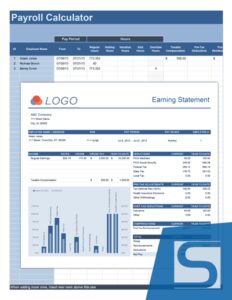
It’s the statement that lists the revenues and expenses for the business for a specific period. Revenues are listed first, and then the company’s expenses are listed and subtracted. Examples of accounts that often require an adjustment include wages payable, accumulated depreciation and prepaid office supplies.
What Are the Main Types of Financial Statements?
Also referred to as the statement of financial position, a company’s balance sheet provides information on what the company is worth from a book value perspective. The balance sheet is broken into three categories and provides summations of the company’s assets, liabilities, and shareholders’ equity on a specific date. In simple interest rate formula either case, your cash flow statement has shown you a different side of your business—the cash flow side, which is invisible on your balance sheets and income statements. Operating activities detail cash flow that’s generated once the company delivers its regular goods or services, and includes both revenue and expenses.
Cash Flow Statement
Accounting is by far one of the most important and prevalent fields in the world today. Its use in organizing business transactions and meeting regulatory requirements makes it a field that requires extensive knowledge and study. As such, accountants make strong salaries and work in a variety of industries. Each time you add or remove an account retired software from palo alto software from your business, it’s important to record it in your books. The statement of retained earnings might also be known as the statement of owner’s equity, an equity statement, or statement of shareholders’ equity. The general guidelines and principles, standards and detailed rules, plus industry practices that exist for financial reporting.
Income Statement a.k.a. Profit and Loss Statement
The accounting cycle is a multi-step process designed to convert all of your company’s raw financial information into financial statements. Through the accounting cycle (sometimes called the “bookkeeping cycle” or “accounting process”). Typically, it’s the operating profit margin that you’ll focus on increasing in order to earn more profit. After all, Congress sets tax rates and interest rates are set by lenders. But EBITDA is determined by your own day-to-day operations—so your operating profit margin is the ratio you have the greatest control over.
Financial Statements (Explanation Part
- The U.S. follows different accounting rules than most other countries.
- Most small businesses track their financials only using balance sheets and income statements.
- Double-entry accounting is also called balancing the books, as all of the accounting entries are balanced against each other.
- Analysts, managers, business owners, and accountants use this information to determine what their products should cost.
- Your cash flow statement, or statement of cash flows, is all of your business’s incoming and outgoing cash.
To set up your statement of retained earnings, use the retained earnings formula. The formula helps you calculate your retained earnings balance at the end of each period. You can either add your statement of retained earnings to your balance sheet. You can use an income statement to look at your profits and losses on a weekly, monthly, quarterly, or annual basis.
A purchase or sale of an asset, loans made to vendors or received from customers, or any payments related to a merger or acquisition are included in this category. The cash flow statement contains three sections that report on the various activities for which a company uses its cash. Investors can also see how well a company’s management is controlling expenses to determine whether a company’s efforts in reducing the cost of sales might boost profits over time.

Tax accounts balance compliance with reporting rules while also attempting to minimize a company’s tax liability through thoughtful strategic decision-making. The reports generated by various streams of accounting, such as cost accounting and managerial accounting, are invaluable in helping management make informed business decisions. As time goes by, you may find yourself wanting to create a new line item for each transaction. However, doing so could litter your company’s chart and make it confusing to navigate. Although this statement is not always considered one of the main financial statements, it is still useful for tracking your retained earnings and seeking outside financing. If it’s positive, that means your business has more incoming money than expenses.
Starting with direct, the top line reports the level of revenue a company earned over a specific time frame. Direct expenses are generally grouped into cost of goods sold or cost of sales, which represents direct wholesale costs. Costs of sales are subtracted from revenue to arrive at gross profit. Gross profit is then often analyzed in comparison to total sales to identify a company’s gross profit margin.
The balance sheet and cash flow statement, however, focus more on the capital management of the firm in terms of both assets and structure. The income statement illustrates the profitability of a company under accrual accounting sample irs form 990 rules. The balance sheet shows a company’s assets, liabilities, and shareholders’ equity at a particular point in time. The cash flow statement shows cash movements from operating, investing, and financing activities.
Keep in mind that your accounting period might be shorter or longer than another business’s period. For example, you might have a monthly accounting period while another company has a quarterly period. Your operations measure the incoming and outgoing cash related to your products or services.
They want to know how much you make, how much you spend, and how responsible your company’s management is with your business finances. This information is a good indicator of whether you’ll be in business long enough to pay off your loan. Say your popsicle cart blows a tire every other month, and you have to pay $50 in maintenance expenses each time. To increase your company’s cash flow from operating activities, you need to speed up your accounts receivable collection.
Tax adjustments help you account for things like depreciation and other tax deductions. For example, you may have paid big money for a new piece of equipment, but you’d be able to write off part of the cost this year. Tax adjustments happen once a year, and your CPA will likely lead you through it.
In other words, deferrals remove transactions that do not belong to the period you’re creating a financial statement for. Generally, experts recommend you keep your cash flow coverage ratio above 1.0 to attract investors. Financial ratios for cash flow can tell you how much cash you have on hand to cover debt, as well as how much of your income you earned during the month was in the form of cash. That’s Suraya’s total cash flow from operations ($700) minus the cash she spent on equipment ($500). Cash flow from financing activities lists money earned collecting interest on loans, credit, and other debt.
